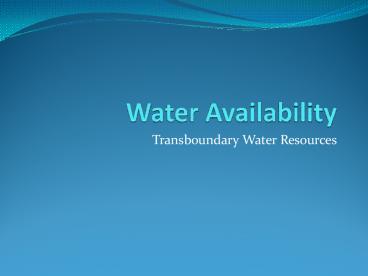Water Availability PowerPoint PPT Presentation
1 / 20
Title: Water Availability
1
Water Availability
- Transboundary Water Resources
2
Global Water Resources
Total 1,386,000,000 km3 Fresh 35,029,000 km3
(2.5 of total)
3
Global Water Cycle
4
Global Water Availability
5
Population and Water Use
global freshwater use is 4000 km3/year 10 of
the renewable supply (44,800km3/year)
6
Global Water Withdrawal
7
Global Water Use
8
(No Transcript)
9
Water Supply and Sanitation
- In 2002
- 1.1 billion people lacked access to improved
water sources (17 of the global population) - Of those, nearly two thirds live in Asia (733
million people) - In sub-Saharan Africa, 42 of the population is
without improved water - 2.6 billion people lacked access to improved
sanitation (42 of the worlds population) - Over half of those live in China and India
(nearly 1.5 billion people) - In sub-Saharan Africa, sanitation coverage is
only 36. - In developing countries, 69 of rural dwellers
lack access to improved sanitation, as opposed
27 of urban dwellers.
10
Water Supply and Sanitation
- Diarrhoea (WHO 2004)
- 1.8 million people die every year from diarrhoeal
diseases (including cholera) 90 are children
under 5, mostly in developing countries - 88 of diarrhoeal disease is attributed to unsafe
water supply, inadequate sanitation and hygiene - Improved access to water supply and sanitation
can reduce diarrhoea morbidity - Water supply 6 25 (108,000 450,000
people) - Sanitation 32 (576,000 people)
- Total 1.026 million
http//www.who.int/water_sanitation_health/disease
s/burden/en/index.html
11
Poverty and Development
- gt 1 billion people live in extreme poverty (lt 1
a day) - Sub-Saharan Africa - gt 15 of every 100 children
die before the age of 5 - Kenya - fertilizer costs gt 2x what it costs in
France or the U.S. - Ethiopia - so deforested that rural households
cannot use manure as fertilizer because they need
it as cooking fuel. - In 2002 developed countries promised to give 210
billion (0.7 of GNP) in ODA to end poverty - 2005 - gave 107 billion (U.S. 28 bln)
- 2008 gave 120 billion (U.S. 26 bln)
- 2015 need 195 billion
4.3 bln for WSS
http//www.unmillenniumproject.org/resources/fastf
acts_e.htm http//stats.oecd.org/qwids
12
Challenges U.S. Response
- Whats the problem?
- Lack of capacity
- Competing interests
- Decentralization
- Its not all about water
- Its also about political will, governance, and
globalization - Senator Paul Simon Water for the Poor Act 2005
- Recognizes importance of water and codified the
internationally agreed goals (MDGs) - Objectives of U.S. strategy
- Increase access to, and effective use of, safe
water and sanitation
http//www.state.gov/documents/organization/125643
13
International River Basins
Over 40 of the world lives in a shared basin
(263 of em)
GEO-3 GLOBAL ENVIRONMENT OUTLOOK
http//www.unep.org/GEO/geo3/english/fig154.htm
14
Water Wars? No.
- Harbingers of conflict that should be considered
- Unilateral development
- Internationalized basin
- No / ineffective institutions
- General animosity
- Downstream hegemony
- Some warning signs
- Large scale development
- Rapid changes
- Civil unrest
15
Water in the International Arena
- We continuously read about the threat of "water
wars" in the press, where one country is likely
to use military force to achieve its objectives
of water use. - Several international groups have warned of the
threat of a "water crisis" looming in the coming
century. - Several area of the world are regularly mentioned
as having tense negotiations over shared river
basins Jordan, Ganges-Bramaputra, and
Tigres-Euphrates. - In US, shared water resources with Canada and
Mexico are now under increased scrutiny and
negotiation resulting from the environmental side
agreement to the North American Free Trade
Agreement. - In EU, multiple water directives are being
implemented across 25 nations.
16
Domestic Water Use
- Survival 5 L/day
- Drinking, cooking, bathing, and sanitation 50 L
- United States 250 to 300 L (Includes yard
watering) - Netherlands 104 L
- Somalia 9 L
- 100-600 L/c/d (high-income)
- 50-100 L/c/d (low-income)
- 10-40 L/c/d (water scarce)
L/c/d liters per person per day
17
Water Stress Index
- Based on human consumption
- linked to population growth
- Domestic requirement
- 100 L/c/d 40 m3/c/yr
- Associated agricultural, industrial energy
need - 20 x 40 m3/c/yr 800 m3/c/yr
- Total need
- 840 m3/c/yr
- about 1000 m3/c/yr
18
Water Stress Index
- Water availability below 1,000 m3/c/yr
- chronic water related problems impeding
development and harming human health - Water sufficiency gt1700 m3/c/yr
- Water stress lt1700 m3/c/yr
- Water scarcity lt1000 m3/c/yr
19
Water Service Level Health
Howard, G. and J. Bartram, Domestic Water
Quantity, Service Level and Health, Report
WHO/SDE/WSH/03.02, World Health Organization, 2003
20
Water Stress (m3/person/year)

